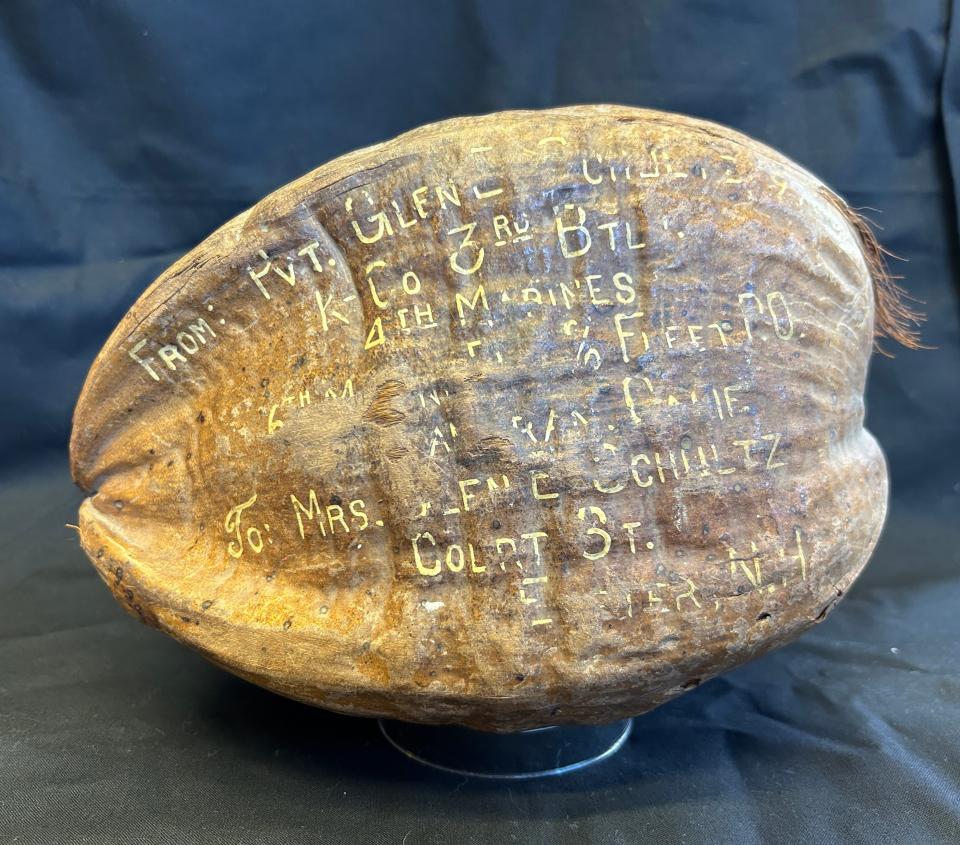Historically Speaking: Exeter’s historical trove unveils a WWII coconut
When asked about the collections in the archives of the Exeter Historical Society – whether they are comprised of papers, images or objects – our best answer is “mixed.”
There are things we’d love to have, like diaries of every early town resident, that simply don’t exist. We’d love to have a firsthand account of Abraham Lincoln’s visit to town, but we don’t. It would be wonderful to have a copy of the Declaration of Independence printed in Exeter in 1776 (these exist, but regularly sell far outside of our ability to bid). We own the press that printed the Declaration of Independence but not the document itself. Most of our collections have been donated by generous people who no longer have space for them. We appreciate these gifts.

Our collection policy states that we can accept items that directly relate to the town of Exeter, New Hampshire. So, most of our collections are from the town – items made here or used here have the most value for our history.
Last month, a man from a neighboring town arrived during open hours carrying a reusable shopping bag. From it, he pulled out a well-wrapped coconut.
“I thought this belonged here,” he told us.
The coconut was very large, decorated with a palm tree on one side and a mailing address on the other- To: Mrs. Glen E. Schultz, Court St. Exeter, NH.
Historically Speaking: North Dakota’s workhorses come to Exeter
Did this tropical item meet our collections policy? Indeed, it did. It was sent from Guam in 1945 by Pvt. Glen Schultz to his wife, Ruby.
There are a number of interesting souvenirs from World War II in our collections. Mostly, they are gathered from the battlefield. Bits and pieces of enemy materials are sometimes re-tooled into ashtrays or pins. Usually, these things are carried home by soldiers.
The writing and decoration on the coconut sent to Ruby Schultz were painted with careful handwriting, possibly done by Glen, but we’re not sure about that. It looks very much like coconuts that can be mailed home from Hawaii today, so it might be something the local population produced for American troops.
Ours is not the only World War II coconut. When researching it, we found other examples of coconuts that were mailed home. A similar one, now located in the National Postal Museum, was mailed in 1944 from Hawaii to Springfield, Massachusetts. The tag indicates postage was 37 cents.
Another coconut, also sent from Hawaii, was mailed to Jackson, Tennessee. There are numerous examples of mailed coconuts that can be found in collections. Our theory is that the practice was either so common that most families have since tossed them out or so rare that only a few are in the public eye. Either way, ours is now part of a wartime coconut kinship group.
Historically Speaking: A look at the 1932 eclipse over Exeter
Probably the most famous coconut from the war is the one carved by a young John F. Kennedy. His patrol boat was struck and destroyed in the Pacific, killing two crew members. After he managed to rescue the remaining men, Kennedy carved a message onto a coconut shell and sent it off with two local men to find help. When he returned from the war, his father had the shell mounted into a paperweight, which later decorated his desk when he became president. It resides at the JFK Presidential Library.
After his posting in Guam, Schultz, who was serving with the 6th Marine Division Raiders, went to Okinawa and was there during the peace treaty between the United States and Japan. He returned to Exeter, where he worked at the Exeter Brass Works. He and Ruby were married for 67 years. The coconut, a peaceful bit of nostalgia from a very ugly war, carried with it an implied message that Glen was okay.
Coconut was still fairly uncommon in the States, so the physicality of its bulk must have been surprising and very exotic. The novelty of it arriving – unwrapped – through the mail would have been a whimsical bit of relief to Ruby. Glen was okay, and to the family’s delight, he later returned safely.
But what to do with something like this when the excitement of its arrival is no longer felt? Over 60 years after it appeared in the mailbox, the coconut was placed on the yard sale table, where it was scooped up by a rescuer.
As he retrieved it from the shopping bag and told us he thought the coconut belonged with the Exeter Historical Society, it became evident that this was an item that needed to be saved. He’d bought a glass case for it and made a stand that propped it up inside – a difficult task due to the irregularities of the coconut husk. Some of the painting was flaking off, so he’d carefully transcribed the words for us. Yes, we wanted this item. Our sometimes hard-to-categorize collections are made stronger for it.
Barbara Rimkunas is the curator of the Exeter Historical Society. Support the Exeter Historical Society by becoming a member. Join online at www.exeterhistory.org.
This article originally appeared on Portsmouth Herald: Historically Speaking: Exeter’s historical trove unveils a WWII coconut

